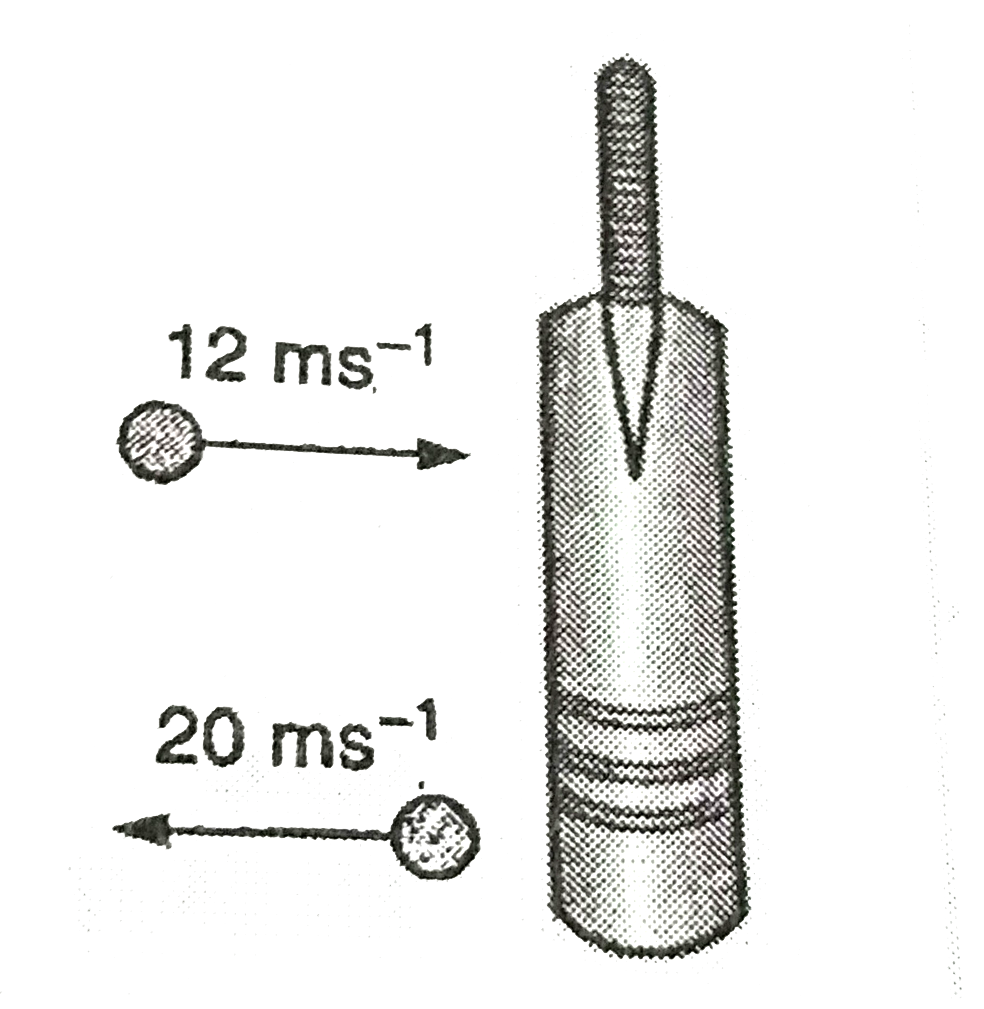A cricketer catches a ball of mass 150 gm. in 0.1 second moving with speed 20ms–1. Then he experiences force of : -
300 N
30 N
3 N
0.3 N
To solve the problem, we need to calculate the force experienced by the cricketer when he catches the ball. We will use the formula for force derived from Newton's second law of motion, which relates force to the change in momentum over time.
1. Identify the given values:
- Mass of the ball, m=150g=0.15kg (since 1 g = 0.001 kg)
- Initial speed of the ball, u=20m/s
- Final speed of the ball after being caught, v=0m/s
- Time taken to catch the ball, t=0.1s
2. Calculate the change in momentum:
- Change in momentum, Δp=m(v−u)
- Substituting the values:
Δp=0.15kg×(0−20m/s)=0.15×(−20)=−3kg m/s
3. Calculate the force experienced by the cricketer:
- Using the formula for force:
F=Δpt
- Substituting the values:
F=−3kg m/s0.1s=−30N
4. Interpret the result:
- The negative sign indicates that the force is in the opposite direction to the motion of the ball. However, since we are interested in the magnitude of the force experienced by the cricketer, we take the positive value:
F=30N
5. Conclusion:
- The force experienced by the cricketer when catching the ball is 30N.
Final Answer:
The cricketer experiences a force of 30 N.
---
- Mass of the ball, m=150g=0.15kg (since 1 g = 0.001 kg)
- Initial speed of the ball, u=20m/s
- Final speed of the ball after being caught, v=0m/s
- Time taken to catch the ball, t=0.1s
- Change in momentum, Δp=m(v−u)
- Substituting the values:
Δp=0.15kg×(0−20m/s)=0.15×(−20)=−3kg m/s
- Using the formula for force:
F=Δpt
- Substituting the values:
F=−3kg m/s0.1s=−30N
- The negative sign indicates that the force is in the opposite direction to the motion of the ball. However, since we are interested in the magnitude of the force experienced by the cricketer, we take the positive value:
F=30N
- The force experienced by the cricketer when catching the ball is 30N.
The cricketer experiences a force of 30 N.
Topper's Solved these Questions
- LAWS OF MOTIONBOOK - AAKASH INSTITUTE ENGLISHCHAPTER - LAWS OF MOTIONEXERCISE - Assignment (SECTION-D) (Assertion-Reason Type Questions)
15 Videos
- LAWS OF MOTIONBOOK - AAKASH INSTITUTE ENGLISHCHAPTER - LAWS OF MOTIONEXERCISE - Assignment (SECTION-B)
44 Videos
- KINETIC THEORYBOOK - AAKASH INSTITUTE ENGLISHCHAPTER - KINETIC THEORYEXERCISE - EXERCISE (ASSIGNMENT) SECTION - D Assertion - Reason Type Questions
10 Videos
- MAGNETISM AND MATTER BOOK - AAKASH INSTITUTE ENGLISHCHAPTER - MAGNETISM AND MATTER EXERCISE - ASSIGNMENT (SECTION D)
26 Videos
Similar Questions
Calculate the de Broglie wavelength of a ball of mass 0.1kg moving with a speed of 30ms−1
View SolutionWhat is the de Broglie wavelength of a ball of mass 0.12 Kg moving with a speed of 20 ms−1 ? What can we infer from this result ?
View SolutionA cricket ball of mass 150 g is moving with a speed of 12ms−1 and is hit by a bat so that the ball is turned back with velocity of 20ms−1 if duration of contact between bat and ball is 0.01 s then:

View SolutionA player caught a criket ball of mass 150 g moving at the rate of 20ms−1 . If the catching process the completed in 0.1s , the force of the blow exerted by the ball on the hands of the player is
View SolutionA player takes 0.1s I catching a ball of mass 150 g moving with velocity of 20 m/s. The force imparted by the bal on the hands of the player is
View SolutionA player catches a ball of 200 gm moving with a speed of 20 m/s. if the time taken to complete the cathc is 0.5s, the force exerted on the player, hand is :-
View SolutionA cricket ball of mass 100 g moving with a speed of 30ms−1 is brought to rest by a player in 0.03 s. Find the change in momentum of ball.
View SolutionA cricket ball of mass 100 g moving with a speed of 30ms−1 is brought to rest by a player in 0.03 s. Find the average force applied by the player.
View SolutionA cricket ball of mass 150 g moving at a speed of 25 ms−1 is brought to rest by a player in 0.03 s. Find the average force applied by the player.
View SolutionA player caught a cricket ball of mass 150g moving at a rate of 20m/s. If the catching process is completed in 0.1s, the force of the blow exerted by the ball on the hand of the player is equal to
View Solution
